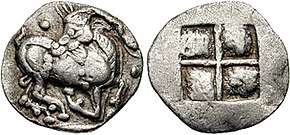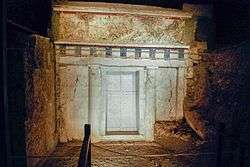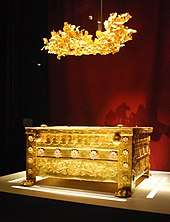Aegae (Macedonia)
Aegae or Aigai (Ancient Greek: Αἰγαὶ), also Aegeae or Aigeai (Αἰγέαι) was the original capital of the Macedonians, an ancient kingdom in Emathia in northern Greece.

The city was also the burial-place of the Macedonian kings, the dynasty which sprang from the Temenid Perdiccas. It was built on a commanding and picturesque site near the modern town of Vergina.[1][2]
The seat of government was afterwards transferred to the marshes of Pella, which lay in the plain beneath the ridge through which the Lydias forces its way to the sea. But the old capital always remained the "hearth" (ἑστία, Diod. Excerpt. p. 563) of the Macedonian kingdom and the burial place for their kings. The body of Alexander the Great was to have reposed at Aegae,[3] where his father Philip II of Macedon fell by the hand of Pausanias of Orestis[4] but it was taken to Memphis through the intrigues of Ptolemy I Soter.
Tomb of Philip II at Aegae (Vergina)
In 1977, Greek archaeologist Manolis Andronikos started excavating the Great Tumulus at Aegae[5] and found that two of the four tombs in the tumulus were undisturbed since antiquity. Moreover, these two, and particularly Tomb II, contained fabulous treasures and objects of great quality and sophistication.[6]
Although there was much debate for some years,[7] as suspected at the time of the discovery Tomb II has been shown to be that of Philip II as indicated by many features, including the greaves, one of which was shaped consistently to fit a leg with a misaligned tibia (Philip II was recorded as having broken his tibia). Also, the remains of the skull show damage to the right eye caused by the penetration of an object (historically recorded to be an arrow).[8][9]
A study of the bones published in 2015 indicates that Philip was buried in Tomb I, not Tomb II.[10] On the basis of age, knee ankylosis and a hole matching the penetrating wound and lameness suffered by Philip, the authors of the study identified the remains of Tomb I in Vergina as those of Philip II.[10] Tomb II instead was identified in the study as that of King Arrhidaeus and his wife Eurydice II.[10] However this latter theory had previously been shown to be false.[9]
More recent research gives further evidence that Tomb II contains the remains of Philip II.[11]
Nearby is the ancient palace of Aegae. The palace is considered to be not only the biggest but, together with the Parthenon, the most significant building of classical Greece.[12] Restoration works on the palace are due to be completed by 2022.[13]
Other tombs
 Great Tumulus of Aegae
Great Tumulus of Aegae The tomb of Philip II of Macedon at the Museum of the Royal Tombs in Vergina
The tomb of Philip II of Macedon at the Museum of the Royal Tombs in Vergina The golden larnax and the golden grave crown of Philip
The golden larnax and the golden grave crown of Philip
See also
References
- Lund University. Digital Atlas of the Roman Empire.
- Richard Talbert, ed. (2000). Barrington Atlas of the Greek and Roman World. Princeton University Press. p. 50, and directory notes accompanying.
- Pausanias. Description of Greece. 1.6.3.
- Diodorus Siculus. Bibliotheca historica (Historical Library). 16.91, 92.
- "Αιγές (Βεργίνα) | Museum of Royal Tombs of Aigai -Vergina". aigai.gr. Retrieved 2018-10-25.
- National Geographic article outlining recent archaeological examinations of Tomb II.
- Hatzopoulos B. Miltiades, The Burial of the Dead (at Vergina) or The Unending Controversy on the Identity of the Occupant of Tomb II. Tekmiria, vol. 9 (2008) Archived 2011-07-28 at the Wayback Machine
- See John Prag and Richard Neave's report in Making Faces: Using Forensic and Archaeological Evidence, published for the Trustees of the British Museum by the British Museum Press, London: 1997.
- "Musgrave J, Prag A. J. N. W., Neave R., Lane Fox R., White H. (2010) The Occupants of Tomb II at Vergina. Why Arrhidaios and Eurydice must be excluded, Int J Med Sci 2010; 7:s1–s15". medsci.org. Retrieved 2018-10-25.
- Antonis Bartsiokas; et al. (July 20, 2015). "The lameness of King Philip II and Royal Tomb I at Vergina, Macedonia". Proceedings of the National Academy of Sciences of the United States of America. 112 (32): 9844–48. Bibcode:2015PNAS..112.9844B. doi:10.1073/pnas.1510906112. PMC 4538655. PMID 26195763.
- New Finds from the Cremains in Tomb II at Aegae Point to Philip II and a Scythian Princess, T. G. Antikas* and L. K. Wynn-Antikas, International Journal of Osteoarchaeology
- "Αιγές (Βεργίνα) | Museum of Royal Tombs of Aigai -Vergina". www.aigai.gr. Retrieved 2020-01-10.
- M, Dattatreya; al (2018-02-28). "Philip II's Massive Palace At Aigai To Be Opened For The Public In May". Realm of History. Retrieved 2020-01-10.
![]()
![]()